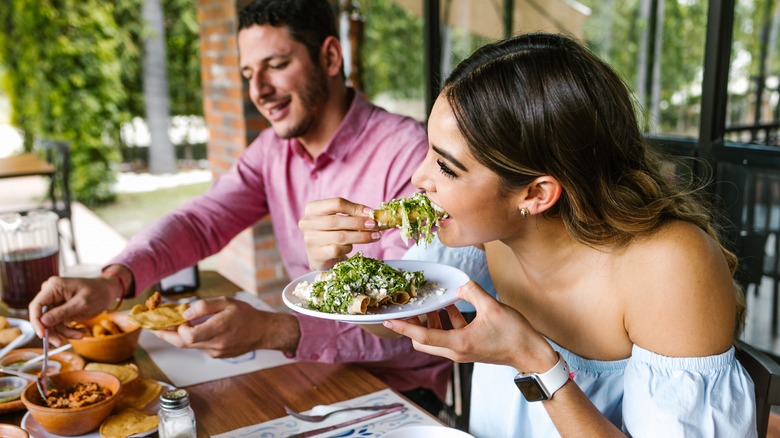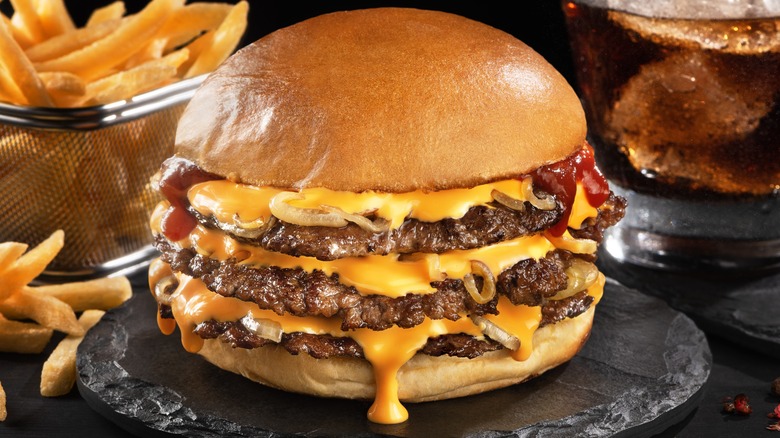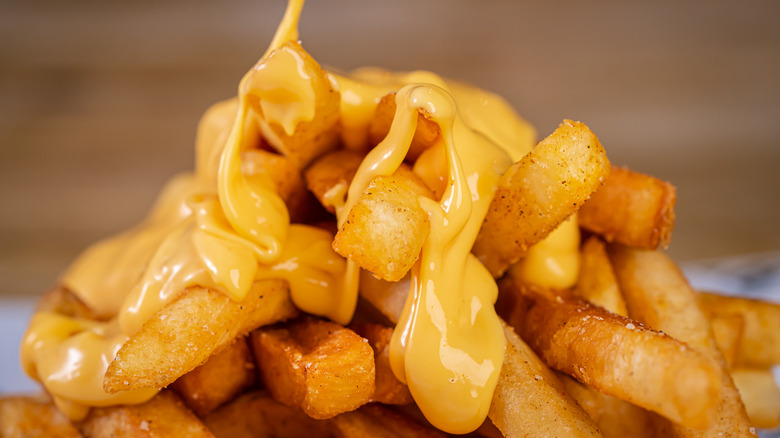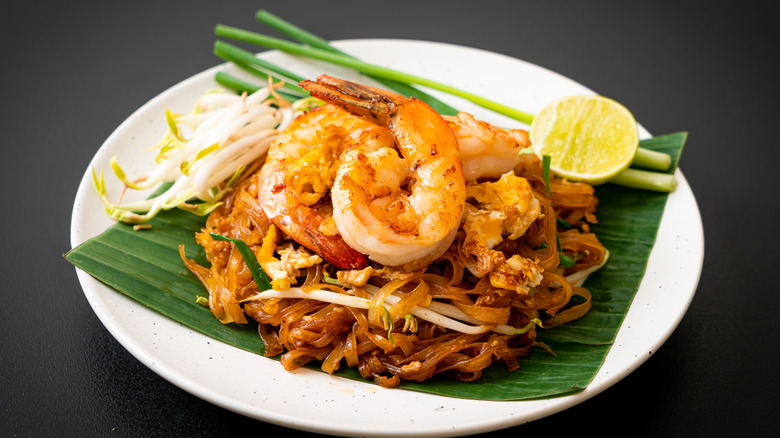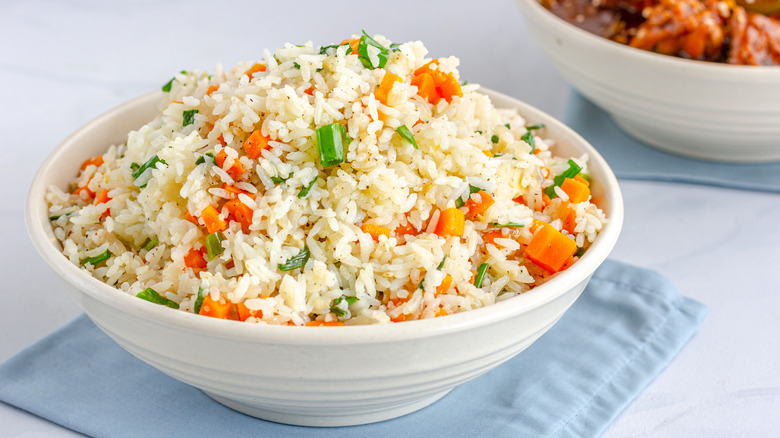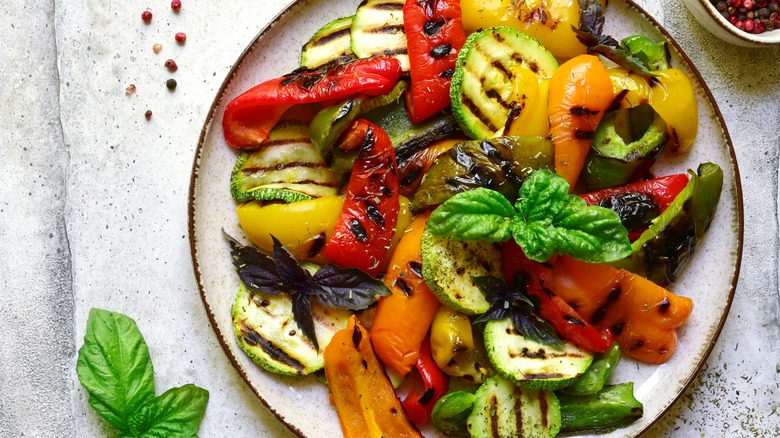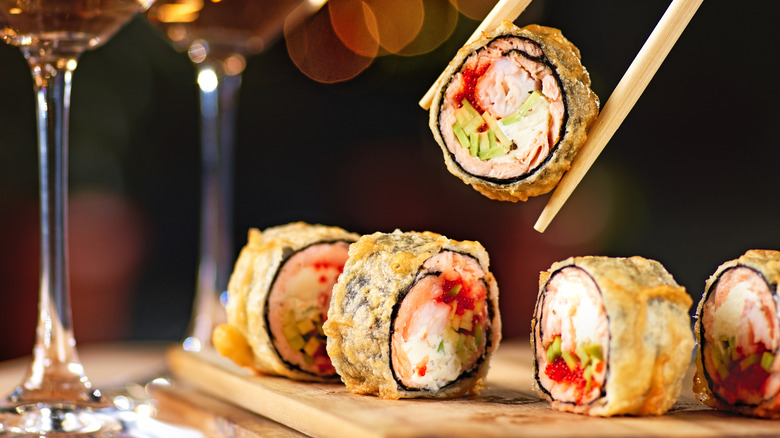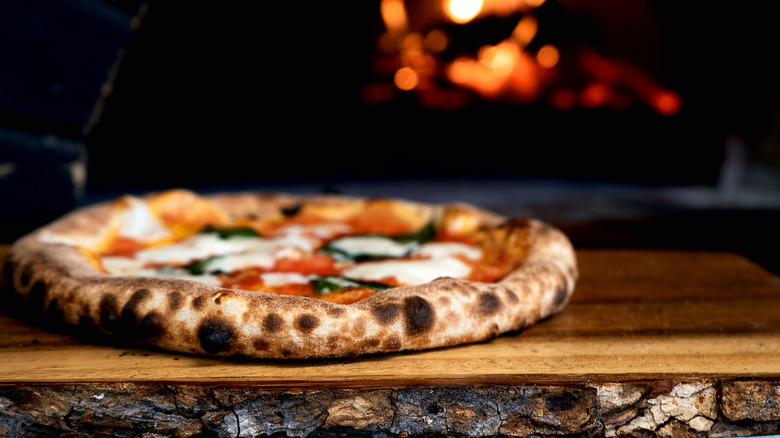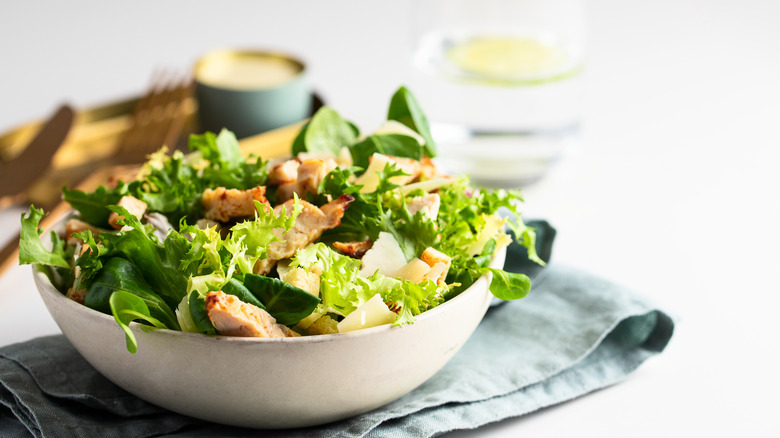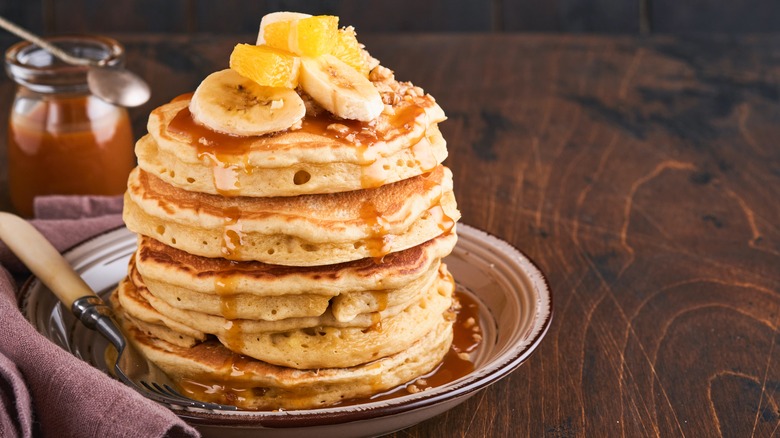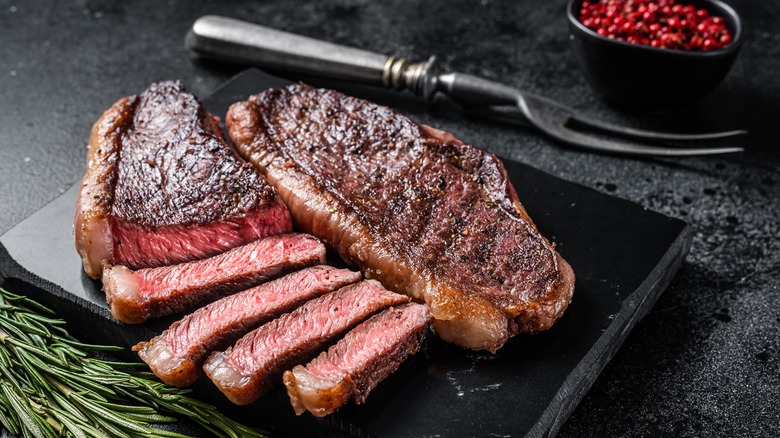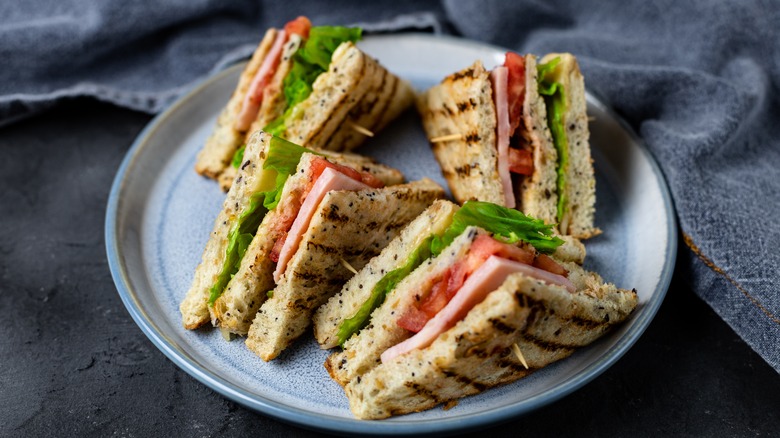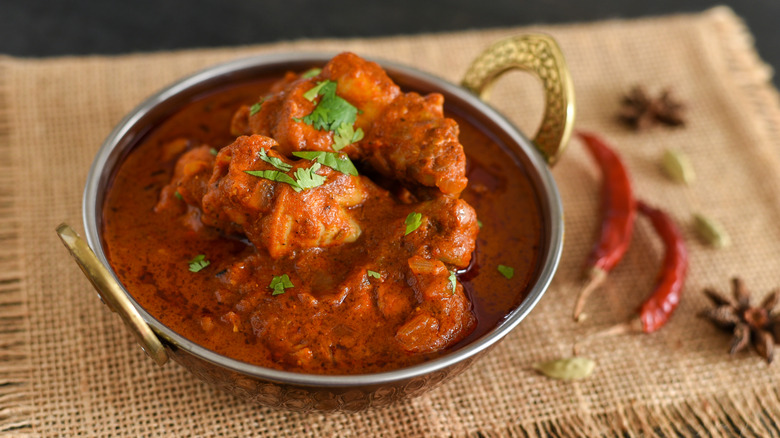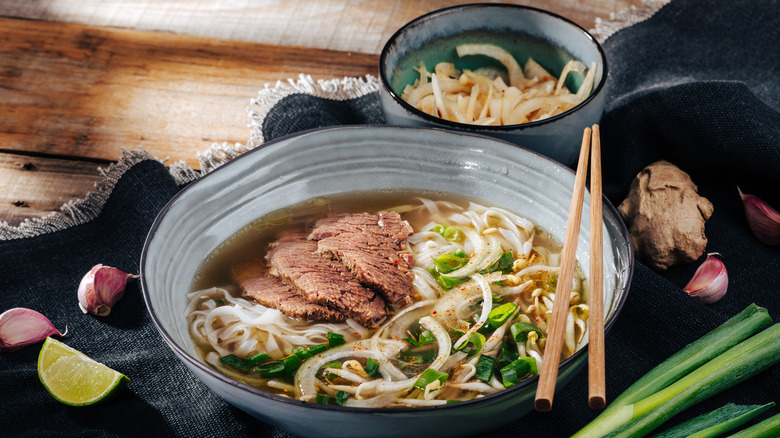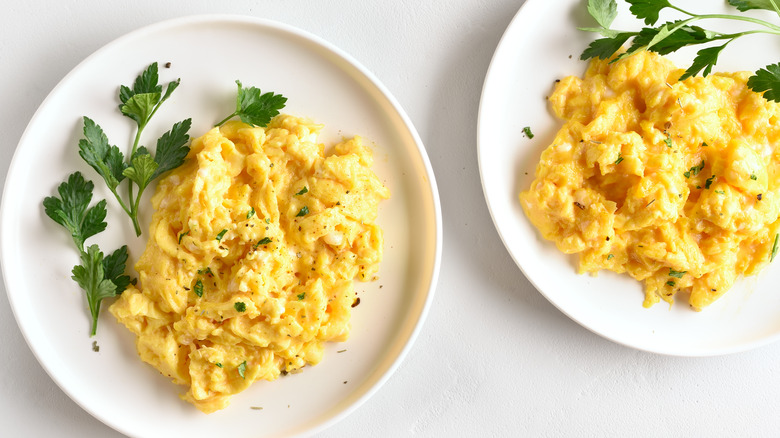Restaurant Foods That Always Taste Better Than What You Make At Home
They say there's nothing like a home-cooked meal, but is that always true? There are many foods that people think taste better when you're out to eat. A recent Tasting Table survey found that there are certain foods people always say are always better in restaurants.
The top three were steak, pancakes, and salads. That makes sense — restaurants prepare these foods differently from how you do at home. They use way more fat and salt than the average home cook. But it's more complicated than that. Apparently, the more we think about food, the less appealing it becomes, which means that cooking is a major appetite buster. It's just a fact: Some foods taste better at restaurants. But that doesn't mean you can't try to make your home versions closer to takeout.
Below, we've compiled a list of restaurant foods that always taste better than what you make at home, as well as some reasons why.
Burgers
Is there anything better than a backyard barbeque or a summer cookout? The friends, the smell of your grill, and hot summer days always draw up sweet nostalgia, but there's something about the food that's never quite precisely what you want it to be. But what makes restaurant burgers taste different from homemade burgers?
The first thing is that restaurants probably use different beef than you, especially if you buy pre-made patties at the supermarket. Chefs pay attention to what a cow ate during its life. For example, meat from cows that ate soy, corn, and other sugary foods is sweeter. So, many restaurants source grass-fed or grass-finished beef.
Next, chefs think about the amount of fat in their burger mixes. Restaurants with great burgers often use meat that is between 20 and 25% fat, leading to a juicier burger. Another critical element of moisture retention is how they cook their burgers. They use meat thermometers to verify they don't serve undercooked meat. Also, by not pressing down on their burgers while they cook on a flat top, chefs can be sure they come out great every time.
Of course, flavor is about more than how restaurants cook their burgers. Seasoning the outside of the patty just before cooking maintains the ideal burger texture without sacrificing flavor. Finally, chefs carefully select toppings like cheeses and buns in different combinations to create unique and delicious burgers.
French fries
What makes fast food and restaurant french fries so delicious? While there's no one secret ingredient that makes them irresistible, there are definitely some techniques that do. First up, most restaurants use russet potatoes for their high starch content, which allows them to get fluffy on the inside and crispy on the outside.
You may also be wondering how fast food restaurants make their french fries crispy. Restaurants use commercial fryers, which means it is difficult to repeat this process at home (though there are smaller versions you can buy to try).
Restaurants also reuse their oil, which, surprisingly, helps fries get crispier. As oil heats, its fats break down and attach to food better. It's a balancing act, though, because oil that's too old can burn and is decidedly not tasty. Speaking of burning, the temperature at which you cook your fries is super important. Most restaurants do a double-fry at a range of 325 and 400 degrees. That's right — most restaurants fry their spuds twice. And they usually choose oils with high smoke points (e.g., peanut, corn, or canola oil).
Restaurants often dehydrate or freeze their potatoes before frying them to ensure they're crispy. Also, sometimes they batter them or add other ingredients, such as dextrose and food starch. It might not be easy to replicate all these tips at home, but incorporating at least some of them will bring your homemade french fries closer to restaurant style.
Pad thai
Pad Thai is an iconic and incredibly popular Thai street food with heavy Chinese influence, per The Atlantic. While there is undoubtedly much more to Thai cuisine than pad Thai, this stir fry is probably the Thai dish most people have tried making at home.
Chef Orachun Yodkamlue told Vice that it's crucial to use high heat when making pad Thai (otherwise, the noodles will stick). Yodkamlue first cooks his protein. He then adds a homemade sauce which includes sriracha, fish sauce, tamarind sauce, and sugar. After, he cooks his aromatics (shallots and dried shrimp). Finally, he adds noodles, more sauce, and stock. But he's not finished yet. Before serving, he adds egg and garnishes. Yodkamlue isn't alone in his opinion — Chef Andy Yang told Michelin that the order you incorporate your ingredients into your pad thai is integral to the success of this dish.
So, if you want to make restaurant-quality pad thai at home, consider making your own sauce and follow the correct order when adding your ingredients.
Fried rice
The reason fried rice tastes better at a restaurant than at home is simple: wok hei. What is wok hei? Michelin translates wok hei to "breath of a wok." Simply put, wok hei is the unique flavor and aroma that high heat and a wok impart to a dish. This phenomenon means that you need to use a wok to make fried rice at home taste as good as at a restaurant. Unfortunately, it's challenging to get heat that is high and direct enough at home. Restaurants place their woks directly onto gas ranges.
You must heat your wok before adding oil. Let the dry wok begin to smoke before adding cold fat, per Chef Andrew Zimmern. To keep everything inside your wok as hot as possible, don't overcrowd your pan and always keep everything moving. Fried rice (or any stir fry) isn't a dish you can walk away from and leave to cook on its own. In restaurants, the direct heat causes a Maillard reaction when heat, tossing, and vaporization meet.
Vegetables
Yes, it's a stereotype that kids (and many adults) don't like their vegetables, but why is that? Think about how that broccoli side dish tastes at your favorite steak house versus how it does when you make it at home. There is a reason why vegetables taste better at restaurants than at home.
The first and most obvious reason is that restaurants use more butter and salt than home cooks do. However, there's more to try than just salt and butter. Add fresh herbs and cheese or use different kinds of fats and types of vinegar. When you add your salt also matters. If you add salt a couple of hours before you cook your veggies, they'll soak it up and be nicely seasoned.
The other element of restaurant-style vegetables is different cooking techniques. You can do so much more than just boil or saute your veggies. Try roasting and grilling them. Most importantly, if you blanch your vegetables in salt water before using another cooking method, they'll turn out crispier and better cooked.
Sushi
Sushi, with its deceptively simple ingredients, seems like it should be easy to make at home. But that simplicity actually explains why sushi tastes better at a restaurant than at home. When your ingredients are simple, they have to be of the utmost quality. If your fish isn't perfect, your sushi isn't going to taste good. Also, sushi chefs are very well trained — some practice for more than a decade before earning their titles.
That said, if you do want to try making sushi at home, there are some key things to keep in mind. Firstly, you shouldn't make homemade sushi too far in advance. That's because refrigerating sushi can affect its taste and quality for the worse, but leaving sushi at room temperature for more than two hours is a health hazard. If you're pressed for time, make your sushi rice ahead of time; it can be placed in the fridge for up to three days.
Tacos
Handmade tortillas are the secret to delicious homemade tacos, so if you've ever wondered why tacos taste better at a restaurant, now you know. Luckily, whether you are in the mood for corn or flour tortillas, they're incredibly straightforward to make. For corn tortillas, you only need masa harina (aka corn flour), water, and salt. And while tortilla presses are great, they're not absolutely necessary when making fantastic corn tortillas. You can place a ball of prepared masa between two pieces of parchment paper and roll it with a rolling pin.
Flour tortillas require a bit more finesse. The best way to ensure fluffy homemade tortillas is to use high-protein flour, a solid fat, and cook them at a high enough temperature. If you make extra tortillas, you can also make your own tortilla chips. They'll be fresh and warm, which isn't something you can achieve with bagged chips from a grocery store shelf.
Pizza
Whether you order takeout from your local chain or dine in at your neighborhood trattoria, pizza is almost always better at a restaurant than at home. Pizza ovens are the number one reason why. A pizza oven is a particular type of oven that most home cooks don't have in their kitchens. They resemble enclosed fireplaces and cook the pizza by heat radiating off the walls. These ovens can also get twice as hot as a home oven, with some reaching 1,000 degrees Fahrenheit.
Of course, pizza ovens aren't the only reason restaurant pizza tastes so good. It's important to know that there's a big difference between pasta and pizza sauce, and you shouldn't use them interchangeably. Namely, you don't cook pizza sauce before you put the pie in the oven. Because pizza ovens are so hot, using a precooked sauce could lead to an overcooked sauce in the final product. Pizza sauce can be as simple as you like. You can simply crush tomatoes, or you can add some tomato paste and seasonings.
Salad
Have you ever wondered why a restaurant salad is so filling and can be a whole meal, whereas it's a struggle to finish one you make at home? Well, salads taste better from a restaurant for a few reasons. For one, your local restaurant probably uses a lot more dressing than you do, and they might make their own, which makes a massive difference.
Many chefs also season the salad itself, adding salt and pepper to the leafy greens even before adding the dressing. Speaking of greens, they're more likely to use a mix of different greens and other ingredients. This combination creates a more exciting dish due to the variety of textures and flavors.
Restaurant salads also have a lot more of another thing many homemade salads are missing: fat. If you're eating salad for its nutritional benefit, consider adding whole fats such as avocado, salmon, or nuts.
Pancakes
There's nothing quite like a stack of thick, fluffy pancakes for breakfast (or any time of day, really). And they always taste better at a diner than at home, don't they? Until now, that is. You can learn how to make pancakes that are (almost) as good as your local diner's. First, make sure that your ingredients are cold. This keeps the chemical leavening reactions from occurring before you cook them. Remember, lumps in your batter are a good thing — they mean you haven't overmixed it.
It's also best not to play with your recipe. If you want buckwheat pancakes, find a recipe for buckwheat pancakes rather than swapping out flour in any old recipe. Don't add blueberries or bananas to a recipe that doesn't call for them. Baking is more of a science than an art, and pancakes are a particularly tricky experiment.
Most diners and restaurants cook pancakes on griddles rather than in pans, which allows them to cook up several at once, all on even heat. NYT Cooking has a neat hack for those of you without a griddle. Writer Jerrelle Guy suggests baking your pancakes in a sheet pan to ensure a large batch of fluffy pancakes is ready simultaneously. Of course, be prepared to forgo the round shape.
Steak
The reason why steak usually tastes better at a steakhouse than at home isn't actually about the cooking method. It's because the meat you buy at the grocery isn't aged how steakhouse beef usually is. Most grocery store meat is wet-aged, meaning it's vacuum-sealed and refrigerated for 10 days. Most steakhouse beef, on the other hand, is dry-aged. That's where the meat is hung in a temperature-controlled room and allowed to grow mold that removes moisture.
You can actually dry-age beef in your own refrigerator. Make sure you have a fridge thermometer and verify your fridge is below 40 degrees Fahrenheit. Next, rinse and dry your cut of beef; then, wrap it in cheesecloth. Put the meat on a wire rack on top of a sheet pan. Then, leave it in the fridge for a week. Make sure to cut off any pieces of fat that developed on the outside as your meat aged. The University of Missouri says that to ensure your meat doesn't go bad, keep your aging environment clean and don't age your beef for too long.
Sandwiches
Science Focus says there's a perfect way to make a sandwich, so perhaps it's no surprise that they taste better from a deli than at home. High-quality ingredients, seasoning, and expert construction methods mean that restaurant and deli sandwiches come out better than ones in your own kitchen.
Science Focus suggests creating a "hydrophobic barrier" by spreading butter or mayonnaise on your bread before adding other ingredients. Doing so keeps your bread from getting soggy. Next, everything must be symmetrical on both sides. Then, when you put your sandwich together, it won't fall apart.
But that's just the construction. Good delis and restaurants ensure they use well-seasoned ingredients, including dressing vegetables, before adding them to the sandwich. Interesting flavor combinations are essential too. Fat and acid go well together, so delis often pair vinegar and mayonnaise, for example. Rather than sliced sandwich bread from the grocery aisle, freshly baked bread can also go a long way.
Indian curries
Obviously, there is more than one type of Indian curry. However, most follow the same pattern, process, and technique; it's the ingredients that change. Following distinct cooking patterns is how restaurants keep their food tasting excellent, dish after dish. These methods are also used by Indian home cooks (via Spice It Upp).
First, chefs and cooks temper whole spices, meaning they heat spices in oil so that their flavor becomes infused into the fat. Next, aromatics such as onions and even tomatoes are added and sauteed. These are followed by powdered spices as well as vegetables or proteins central to the dish. The next step is adding the liquid that will provide the base of the curry gravy. Finally, before serving, chefs add garnishes, such as cilantro or roasted garam masala powder.
When attempting to replicate restaurant-style flavor, it's essential to use the ingredients listed in the recipe and in the form called for; if the recipe says a cinnamon stick, don't substitute it with powdered cinnamon. Further, don't be intimidated by the amount of oil in the recipe. A lot of it will be drained off or reused elsewhere.
Phở
A good stock is the secret to restaurant-quality phở. In fact, according to Vietnam Tourism, the dish was created in part because of an excess of beef bones due to the French colonizers' high demand for beef. There isn't just one way to make this traditional breakfast dish. However, making bone stock from scratch is a time-intensive process that sets restaurant dishes apart from home ones that use premade broths.
Take Charles Phan's phở bo recipe, for example. While the individual steps aren't particularly complicated, they are abundant and take plenty of time. Phở is a dish that is certainly easier to leave up to your local restaurant, but that doesn't mean you shouldn't try it at home. One of the great things about this noodle soup is it uses up animal parts that might otherwise go to waste. These parts are often more affordable than other cuts of meat, as well.
Scrambled eggs
You've probably wondered why scrambled eggs taste better from a restaurant than at home. It's only a few simple ingredients, after all. For one, you may have heard that adding milk to your scrambled eggs is an incredible hack. Not so much. It makes them rubbery and bland. Instead, add water (half a teaspoon per egg), which helps create steam while the eggs cook. That way, the proteins don't bind too quickly and are actually fluffier rather than tough and dense.
We get it — you're hungry and just want breakfast on the table. But don't be tempted to crank up the heat so that your eggs cook quickly. That'll just lead to dry, rubbery eggs. Most chefs recommend cooking scrambled eggs between low and medium heat. Some chefs, such as Mark Bitterman, cook scrambled eggs for as long as 30 minutes (per NYT Cooking). This may seem like a dish that should be ready in a jiffy, but your local diner is likely the only place where you'll get perfect scrambled eggs served up in minutes.
